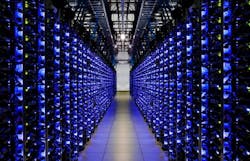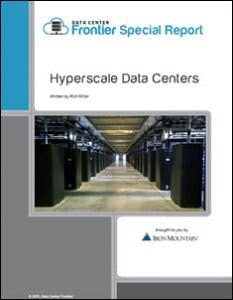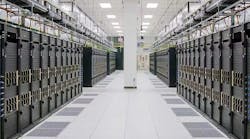Data Center Frontier continues to explore the fastest growing markets and niches in the data center market via our DCF Special Reports. This time around, Data Center Frontier partners with Iron Mountain to explore the hyperscale data center market, and how its growth has changed how we compute. This excerpt from a recent Hyperscale Data Center report explores the influence of hyperscale customers, the geography of hyperscale data centers — and what sets them apart.
Download the full report.
Synergy Research estimates that there are 439 hyperscale data centers worldwide. Meanwhile, 451 Research says it tracks 6,100 data centers globally. Although hyperscale data centers represent less than 10 percent of data centers by number, they represent an outsized share of new investment in infrastructure and servers.
Capital expenditures by the 20 largest global hyperscale providers surged 43 percent in 2018 to almost $120 billion, according to Synergy Research. In some markets, hyperscale leasing represents the lion’s share of activity. JLL estimates that hyperscale deals of 6 MWs or more represented 83 percent of leasing in Northern Virginia in 2018.
Meanwhile, server sales for companies that focus on custom hardware for hyperscale operators have been rising. IDC reports that about 30 percent of server sales in the first quarter of 2019 went to specialists in hyperscale gear, including ODM (original design manufacturing) vendors and Open Compute specialist Inspur.
“Hyperscalers will continue to heavily influence the IT infrastructure industry, both by the scale of their infrastructure investments and with the innovations those investments generate,” said Kuba Stolarski, research director, Computing Platforms, Worldwide Infrastructure, at IDC.
Over time, the global population of hyperscale facilities could grow to 10,000 or more data centers, according to an analysis by James Hamilton of AWS, who predicts that the need for latency and redundancy will create interconnected cloud clusters across the globe. The rapid adoption of AI will help drive this growth in hyperscale customers and demand, which underscores the outsized impact of the hyperscale sector going forward.
How a Hyperscale Data Center is Different
The design and construction of hyperscale facilities diverge from traditional enterprise data center space in a number of ways. Here are some examples:
REAL ESTATE AND SITE SELECTION
Hyperscale operators grow faster than enterprise companies. As deal sizes have grown, building and campus standards have grown as well. Facebook’s early campuses featured three data center buildings of about 330,000 SF each. The company’s recent campuses have room for up to seven buildings of about 450,000 SF. This trend has also been reflected in new campuses being built by data center REITs, which are now typically designed for between 100 MW and 150 MW of capacity, with long-term roadmaps for up to 350 MWs or more.
POWER SOURCING
Most major hyperscale operators are deeply committed to sustainability, and have ESG (Environmental, Social and Governance) policies that commit them to reducing their carbon footprint, and in some cases operating with 100 percent renewable energy. As a result, the ability to procure solar, wind or hydro-electric power is critical in landing hyperscale tenants. Depending upon the market, renewables can be provisioned through local utilities or by intermediaries (power brokers) that arrange power purchase agreements (PPAs) or other vehicles to offset a data center’s energy requirements. A growing number of data center providers are developing teams that specialize in navigating the complexities of the energy markets.
POWER INFRASTRUCTURE
Energy efficiency is extremely important to hyperscale players, who seek to operate at low Power Usage Effectiveness (PUE) ratings. This can include a simplified power distribution design that reduces or eliminates conversions between AC and DC or “stepping down” voltage for servers. As an example, Google brings 48-volt power to its server motherboards, rather than the traditional 12 volts, reducing energy usage by as much as 30 percent. Some hyperscale operators also can innovate in the design of uninterruptible power supplies (UPS), foregoing centralized UPS systems in favor of in-row units or server-level solutions using on-board batteries or even fuel cells.
SOFTWARE-FOCUSED RESILIENCY
Cloud computing is bringing change to how companies approach uptime, introducing architectures that create resiliency using software and network connectivity. This includes the use of availability zones (AZs) by cloud platforms, especially Amazon Web Services. AZs are clusters of data centers within a region that allow customers to run instances of an application in several isolated locations to avoid a single point of failure. The adoption of cloud regions and AZs has become important in site selection and the configuration of data center footprints for hyperscalers.
COOLING METHODOLOGY
Hyperscale operators have been innovators in cooling, pioneering the use of fresh air cooling, higher operating temperatures for server inlet air, and other strategies designed to reduce the use of energy for air conditioning. Cooling has been the focus of constant refinement and optimization for hyperscale users, some of whom have adopted Kyoto Cooling (indirect air), membrane-based evaporative cooling (Facebook), water to the chip (Google), or rear-door chilling units (LinkedIn).
DATA HALLS
Wholesale providers have shifted to larger data halls spanning between 35,000 to 85,000 SF and supporting as much as 9 megawatts of critical power. This positions providers to compete for larger deals, including AZs for cloud providers seeking to provide geographic diversity for workloads. Developers are also refining their construction techniques, providing better per-megawatt costs on projects using larger rooms. If a hyperscale tenant doesn’t emerge, these rooms can be subdivided to house smaller requirements (albeit with the tradeoff of slightly lower returns).
The Geography of Hyperscale Data Centers
In the early days of the hyperscale trend, major cloud computing campuses were often closer to cows than cities, helping create data center building booms in rural areas of Oregon, Iowa and North Carolina. That’s starting to change, as cloud growth and new workloads push data storage closer to end users.
The result: More huge data centers are coming to the suburbs of major American cities, shifting servers closer to consumers. This shift in architecture will gain momentum in coming years, boosting the concentration of hyperscale capacity near tech-centric population hubs with Phoenix, Dallas, Chicago, Northern Virginia and other markets.
Perhaps an even larger trend is globalization, as hyperscale providers seek to position data center capacity to serve growing audiences in Europe, Asia, South America and even Africa.
“Cloud provider demand continues to drive strong growth in the top data center markets and we expect that to spread beyond the top 20 global markets in the coming years,” said Kelly Morgan, VP of Datacenter Services & Infrastructure at 451 Research. “Some individual markets may see supply growth of 20% or higher, while other slower-growth markets will offset that to provide single-digit growth overall.”
More huge data centers are coming to the suburbs of major American cities, shifting servers closer to consumers.
This global growth has driven significant merger activity as the industry’s largest players—including Digital Realty, Equinix, CyrusOne and Iron Mountain — have acquired companies that provide regional expertise and existing footprints in Europe, Asia and South America.
Stay tuned; next week, the last excerpt in this Hyperscale Data Center Market report series will explore the future of hyperscale.
In the mean time, catch up on previous entries below:
- Reshaping the Global IT Landscape: The Impact of Hyperscale Data Centers
- Who are the Data Center’s Industry’s Hyperscale Players?
Download the full report, “Hyperscale Data Centers,” courtesy of Iron Mountain Data Centers, to learn more about how hyperscale computing has changed the supply chain for digital infrastructure, and how this computing shift will evolve.







